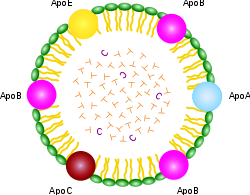- Chylomicron
-
 Chylomicron structure
Chylomicron structure
ApoA, ApoB, ApoC, ApoE (apolipoproteins); T (triacylglycerol); C (cholesterol); green (phospholipids)Chylomicrons are lipoprotein particles that consist of triglycerides (85-92%), phospholipids (6-12%), cholesterol (1-3%) and proteins (1-2%).[1] They transport dietary lipids from the intestines to other locations in the body. Chylomicrons are one of the five major groups of lipoproteins (chylomicrons, VLDL, IDL, LDL, HDL) that enable fats and cholesterol to move within the water-based solution of the bloodstream.
Contents
Function
Chylomicrons transport exogenous lipids to liver, adipose, cardiac, and skeletal muscle tissue, where their triglyceride components are unloaded by the activity of lipoprotein lipase. As a consequence, chylomicron remnants are left over and are taken up by the liver.
Origin
Chylomicrons are a type of lipoprotein produced in absorptive cells of small intestines, specifically, the epithelial cells within the villi of the duodenum.
Stages
There are three stages in the chylomicron's "life cycle":
- Nascent chylomicron
- Mature chylomicron
- Chylomicron remnant
Nascent chylomicrons
Chylomicrons are created by the absorptive cells of the small intestine, known as enterocytes. They are relatively large, having a diameter of 75 to 1,200 nm. These nascent chylomicrons are released by exocytosis from enterocytes into lacteals, lymphatic vessels originating in the villi of the small intestine, and are then secreted into the bloodstream at the thoracic duct's connection with the left subclavian vein.
Nascent chylomicrons are primarily composed of triglycerides (85%) and contain some cholesterol and cholesteryl esters. The main apolipoprotein component is apolipoprotein B-48 (APOB48).
Mature chylomicron
While circulating in lymph and blood, chylomicrons exchange components with high-density lipoproteins (HDL). The HDL donates apolipoprotein C-II (APOC2) and apolipoprotein E (APOE) to the nascent chylomicron and thus converts it to a mature chylomicron (often referred to simply as "chylomicron"). APOC2 is the cofactor for lipoprotein lipase (LPL) activity.
Chylomicron remnant
Once triglyceride stores are distributed, the chylomicron returns APOC2 to the HDL (but keeps APOE), and, thus, becomes a chylomicron remnant, now only 30–50 nm. APOB48 and APOE are important to identify the chylomicron remnant in the liver for endocytosis and breakdown.
References
- ^ M Mahmood Hussain: "Review Article: A proposed model for the assembly of chylomicrons"; Arterosclerosis; Vol. 148; 2000; pages 1-15;
Apolipoproteins Lipoproteins Extracellular enzymes Lipid transfer proteins Cell surface receptors ATP-binding cassette transporter 
This protein-related article is a stub. You can help Wikipedia by expanding it.
